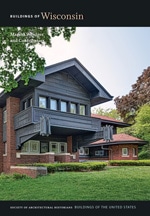
Louis W. Claude’s simple, compact designs rooted in the Arts and Crafts movement appealed to local library commissions that had received Carnegie funding. His plans and architectural vocabulary for libraries became fairly standardized, with an open-plan reading room, anchored at the rear by a circulation desk and bounded by built-in bookcases. Built-in benches near the entrance, built-in cabinetry, and a small nook with a fireplace helped create a homelike atmosphere. And yet many of the firm’s libraries, like this one, were one of a kind in their exterior expression. This library has rough stuccoed walls and pronounced horizontality, emphasized by the shadows cast by the generous overhangs, the ribbon of windows beneath the eaves, and the stringcourse delineating the top of the quarry-faced stone water table. But pairs of long windows flanking the entrance pavilion emphasize verticality. This detail, along with the off-center front-gabled entrance, the scroll-sawn rafter tails along the eaves and the tops of mullions, and the scrolled blocks at the bottoms of the mullions lend a cottage-like appearance.
Kilbourn was the original name of the city, until it was changed to Wisconsin Dells in 1931 in an effort to promote the area’s natural features as tourist attractions.






